Ukulele Body Styles
DaSilva Ukulele Co. makes ukuleles in all sizes including standard soprano, concert, tenor and baritone scale lengths. Our proven body shapes include original designs in the typical ukulele shapes as well as pineapple shapes, and exact reproductions of Martin body shapes and detailed copies of Dias and Santo (ca. 1890) soprano instruments. The size and shape of the ukulele certainly is one of the major design factors for how it will sound.
Soprano Styles
| ca. 1890 Dias reproduction | ca. 1890 Santo reproduction | Martin | DaSilva | Pineapple |
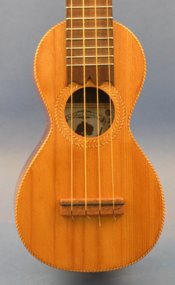 |
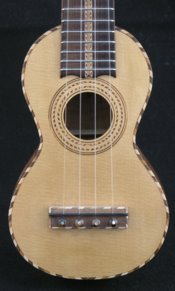 |
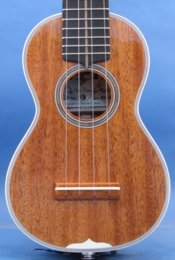 |
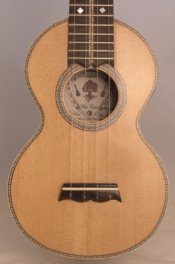 |
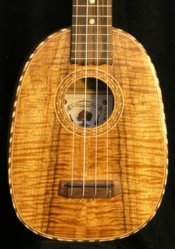 |
| 13.0 inch scale | 13.0 inch scale | 13.65 or 13.75 inch scale | 13.75 inch scale | 13.75 inch scale |
Concert Styles
| DaSilva | Martin | Pineapple |
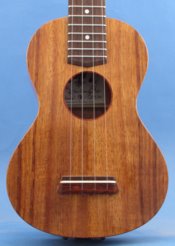 |
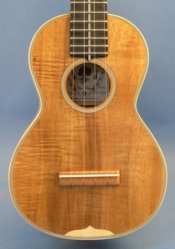 |
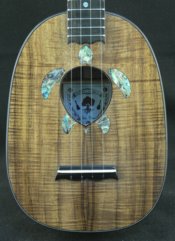 |
| 15.50 inch scale | 15.50 inch scale | 15.50 inch scale |
Tenor & Baritone Styles
| DaSilva Tenor | Thin Body Tenor | James Hill Tenor | Martin Baritone | DaSilva Baritone |
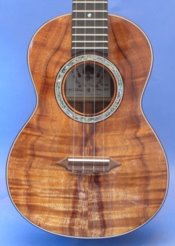 |
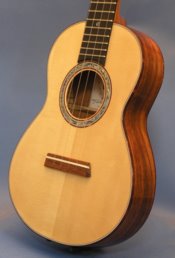 |
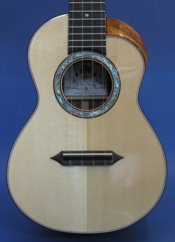 |
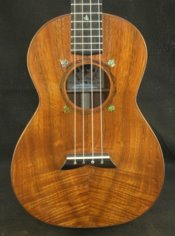 |
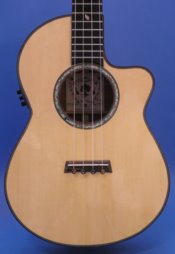 |
| 17.00 inch scale | 17.00 inch scale | 17.00 inch scale | 20.25 inch scale | 20.75 inch scale |
Wood
DaSilva Ukulele Co. builds instruments only with the highest quality, well-seasoned, well-quartered and perfectly prepared tonewoods. Our wood stocks are some of the best amongst custom builders which allows us to easily select a special and unique set for your instrument. While it certainly is possible to fashion a ukulele out of just about any wood these days, we refuse to sacrifice instrument tone and volume for a certain look. We believe in order to build the best sounding instrument possible, the wood choice should not unduly restrict the possibilities. In order to maximize our knowledge and experience with wood, we have begun to scientifically measure and test each species and even specific wood sets to fully understand an instruments resulting tonal characteristics. Coupled with the hands-on experience of Michael DaSilva personally selecting, thicknessing and flexing and tap-tone testing over 300 instruments allows us deliver the maximum dynamic range for any instrument.
Top Woods
The best top wood is light and stiff - with our actual measurement and study of the available species we can select the right top wood for you. Contrary to popular belief, just because a wood is called a tonewood, and just because it has been shown to be an adequate back and side wood, does not mean that it will perform adequately as a top wood. For instrument tops we primarily select from premium Sitka and Adirondack spruce, Spanish cedar, Honduras and Sapele mahogany, and figured and non-figured koa. We have also successfully used Douglas Fir, Yellow cedar, salvage redwood, mango and locally harvested acacia. We have also built some incredibly great sounding instruments with carbon-fiber tops.
| Sitka Spruce | Adirondack Spruce | Honduras Mahogany | Curly Koa | Douglas Fir |
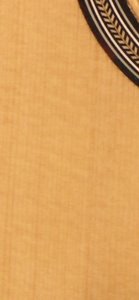 |
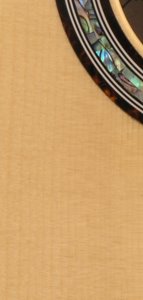 |
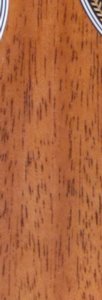 |
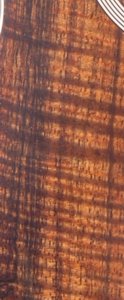 |
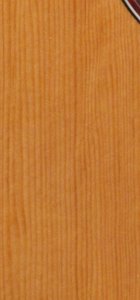 |
Back & Sides
Back and side woods do not need to be as stiff and light as top wood. They do need to be strong though. With more forgiving requirements, lots more species are available for back and sides than for tops. The selection of the back and sides wood can affect the final tone of an instrument but not in ways that most people think. Usually it does not contribute significantly to a better sound as it is not directly driven by the strings as is the top wood, but it certainly can adversely affect the tone and volume of an instrument by being thicker and heavier than necessary, too dense, or lacking in the ability to vibrate sympathetically. Proper construction can minimize these affects but wood selection is still important.
Often, the back and side wood is selected for its figure and aesthetic look it gives to an instrument. Common back and side wood for ukuleles include the many varieties and level of figure with koa, mahogany, maple, myrtle, mango, rosewood, ziricote, and ebony. You can get a good idea of the possibilities by viewing the selection of previously built DaSilva Ukulele Co. instruments in the Photo Gallery.
Neck
As evidenced by the multitude of perfectly playing vintage Martin ukuleles from as early as the 1920's, the perfect neck wood continues to be well-quartered, well seasoned, Honduras mahogany. This is clearly our preferred choice of neck wood. We also build with Spanish cedar when low weight is the goal and will use koa and maple for decorative purposes. While there are many builders reinforcing all their necks with carbon-fiber these days, we only selectively incorporate such use in our necks. With the majority of over 300 instruments in customer hands over the last 8 years without any neck problems we have come to the conclusion that carbon-fiber reinforcement might be overkill. We do however, plan to measure and scientifically analyze the typical neck stresses to validate this conclusion. Stay tuned.
Construction
Given a certain body style and instrument dimensions and selected species and pieces of wood, how an instrument is constructed is the final determining factor in how good it will sound. Another way to look at this situation is that the builder cannot add to the potential of the design and selected wood, but is almost always able to prevent the expression of this potential if they were to do the wrong thing. Quite humbling at times, but quite rewarding when it all comes together.
So, how do I do it? As anyone can plainly see by looking into any ukulele, there are no real secrets about how any instrument is put together. With a little measurement even the tiniest details like how thick the top is, the pattern of braces and how they are carved, even the thickness of the finish gives themselves up. And the result, good or bad, is right there to evaluate.
That is how I got started. Playing lots of good instruments, measuring them, even taking an old Martin apart. By evaluating the individual parts I was able to get a feel for what went into each instrument. But that was only the beginning. In order to understand how specific changes might affect the sound, I had to find the limits of those changes. Sort of old school destructive testing. Soon, I had a feel for how far I could push the material (wood) to give me what I wanted. This process never really ends. Each new instrument is a test and a validation for how I do things.
Finally, I view an instrument as a system of components. When each component is optimized, the system often produces something greater than the sum of the parts. If one part is not quite right, usually that is not enough to create a bad result, but it does insure that it is not the best. With that in mind, I approach the building of ukuleles with one thing in mind, in that, "everything matters". Be assured, that in getting a DaSilva ukulele, that each process and each part was consciously considered the best I could produce as it became part of the instrument.
DaSilva Ukulele Co. § 2547-8th Street #28, Berkeley, California 94710 § 510-649-1548 § info@ukemaker.com
Copyright © 2012 Michael DaSilva
